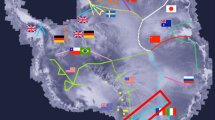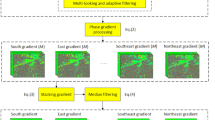Abstract
The development of satellite technology is rapidly increasing the evolution of remote sensing. Satellite images give extensive useful information about the land structure that is easily manageable in the process of generating true, high-speed information which allows the forecasting of future environmental and urban planning. Remote sensing comprises active and passive systems. Passive sensors detect natural radiation that is emitted or reflected by the object or surrounding area being observed. Active systems which produce their own electromagnetic energy and their main properties are their ability of collecting data in nearly all atmospheric conditions, day or night. These systems are frequently used to generate a digital elevation model (DEM) because they cover large areas. DEM supplies essential data for applications that are concerned with the Earth’s surface and DEMs derived from survey data are accurate but very expensive and time consuming to create. However, the use of satellite remote sensing to provide images to generate a DEM is considered to be an efficient method of obtaining data. Interferometric Synthetic Aperture Radar (InSAR) is a new geodetic technique for determining earth topography. InSAR measurements are highly dense and they only give information in Line of Sight of Radar. In the study, interferograms were produced from the InSAR images taken by ERS satellites in 1992 and 2007 and we developed the methods to generate a DEM using the InSAR technique and present the results relating to Kayseri Province in Turkey. The accuracy of the DEM derived from the InSAR technique is evaluated in comparison with a reference DEM generated from contours in a topographical map.









Similar content being viewed by others
References
Abdikan S (2006) Interferometric SAR images produced of the digital elevation model of the stereo and quality investigation. M.Sc.Thesis, Yıldız Technical University, Istanbul
Arora MK, Patel V, Sharma ML (2006) SAR Interferometry for DEM generation, GIS Development, http://www.gisdevelopment.net/technology/rs/techrs0021.htm
Bechor BD, Zebker H (2006) Measuring two-dimensional movements using a single InSAR pair. Geophys Res Lett 33. doi:10.1029/2006GL026883
Çakır Z (2003) Analysis of the crustal deformation caused by the 1999 Izmit and Düzce Earthquakes using Synthetic Aperture Radar Interferometry. Ph.D. thesis, Istanbul Technical University, Istanbul
Chen CW, Zebker HA (2001) Network approaches to two-dimensional phase unwrapping: intractability and two new algorithms. J Opt Soc Am 17:401–414
Chen CW, Zebker HA (2002) Phase unwrapping for large SAR interferograms: statistical segmentation and generalized network models. IEEE Trans Geosci Remote Sens 40:1709–1719
Colesanti C, Wasowski J (2006) Investigating landslides with space-borne Synthetic Aperture Radar (SAR) interferometry. Eng Geol 88:173–199
Erdogan S (2009) A comparison of interpolation methods for producing digital elevation models at the field scale. Earth Surf Process Landforms 34(3):366–376
Ge L, Chang HC, Rizos C, Trinder J (2004) Multipass differantial radar interferometry with the aid of GIS. Int Arch Photogramm Remote Sens Spat Inf Sci 34:150–161
Graham LC (1974) Synthetic interferometer radar for topographic mapping. Proceeding of the IEEE 62(6):763–768
Huurneman G (1999) SAR interferometry. ITC Course notes, Enschede
Kampes B (1999) DORIS User’s manual and Technical documentation, Delft University of Technology
Kimura H, Yamaguchi Y (2000) Detection of landslide areas using satellite radar interferometry. Photogramm Eng Remote Sens 66:337–344
Köse O (2000) North Anatolian fault zone in the tectonic stress accumulation points with remote sensing techniques to determine. Ph.D. thesis, Hacettepe University, Ankara
Magnard C, Meier E, Rüegg M, Brehm T, Essen H (2007) High resolution millimeter wave SAR interferometry. In: IEEE International Geoscience and Remote Sensing Symposium, Barcelona, Spain, 23 July 2007
Massonnet D, Feigl KL (1998) Radar interferometry and its application to changes in the earth’s surface. Rev Geophys 36(4):400–441
Rumsey HC, Morris GA, Green RR, Goldstein RM (1974) A radar brightness and altitude image of a portion of Venus. Icarus 23:1–7
Sefercik UG (2007) Radar interferometri tekniği ile SYM üretimi ve doğruluk değerlendirmeleri. TMMOB Harita ve Kadastro Mühendisleri Odası, 11.Türkiye Harita Bilimsel ve Teknik Kurultayı, Ankara
Şengün YS (2009) GPS ve Insar ölçülerini birlikte kullanarak İzmit depreminde oluşan deformasyonların belirlenmesi: Nokta seyrekleştirmede yeni bir algoritma. Doktora Tezi, İstanbul Teknik Üniversitesi, İstanbul
Smith L (2002) Emerging applications of Interferometric Synthetic Aperture Radar (InSAR) in geomorphology and hydrology. Ann Assoc Am Geogr 92(3):385–398
Snaphu (2005) Statistical-Cost, Network-Flow Algorithm for phase unwrapping (SNAPHU), Stanford University, http://www-star.stanford.edu/sar
Tolluoglu D (2006) Monitoring deformations on Tendürek Volcano by differential SAR interferometry. M.Sc.Thesis, Yüzüncü Yil University, Van
Wegmüller U, Santoro M, Werner C, Strozzi T, Wiesmann A, Lengert W (2009) DEM generation using ERS–ENVISAT interferometry. J Appl Geophys 69:51–58
Wright T (2000) Crustal deformation in Turkey from Synthetic Aperture Radar Interferometry. Ph.D.Thesis, University of Oxford
Zebker HA, Goldstein RM (1986) Topographic mapping from interferometer SAR observations. J Geophys Res 91:4993–5000
Zhou Y, Stein A, Molenaar M (2003) Integrating interferometric SAR data with levelling measurements of land subsidence using geostatistics. Int J Remote Sens 24(18):3547–3563
Acknowledgment
We are grateful for the financial support for all stages of this study from the Erciyes University Scientific Research Projects Coordination Unit under project numbers FBA-12-3749 and FBA-07-46. We would also like to thank Dr. Batuhan Osmanoglu for his assistance in the data evaluation.
Author information
Authors and Affiliations
Corresponding author
Rights and permissions
About this article
Cite this article
Geymen, A. Digital elevation model (DEM) generation using the SAR interferometry technique. Arab J Geosci 7, 827–837 (2014). https://doi.org/10.1007/s12517-012-0811-3
Received:
Accepted:
Published:
Issue Date:
DOI: https://doi.org/10.1007/s12517-012-0811-3




